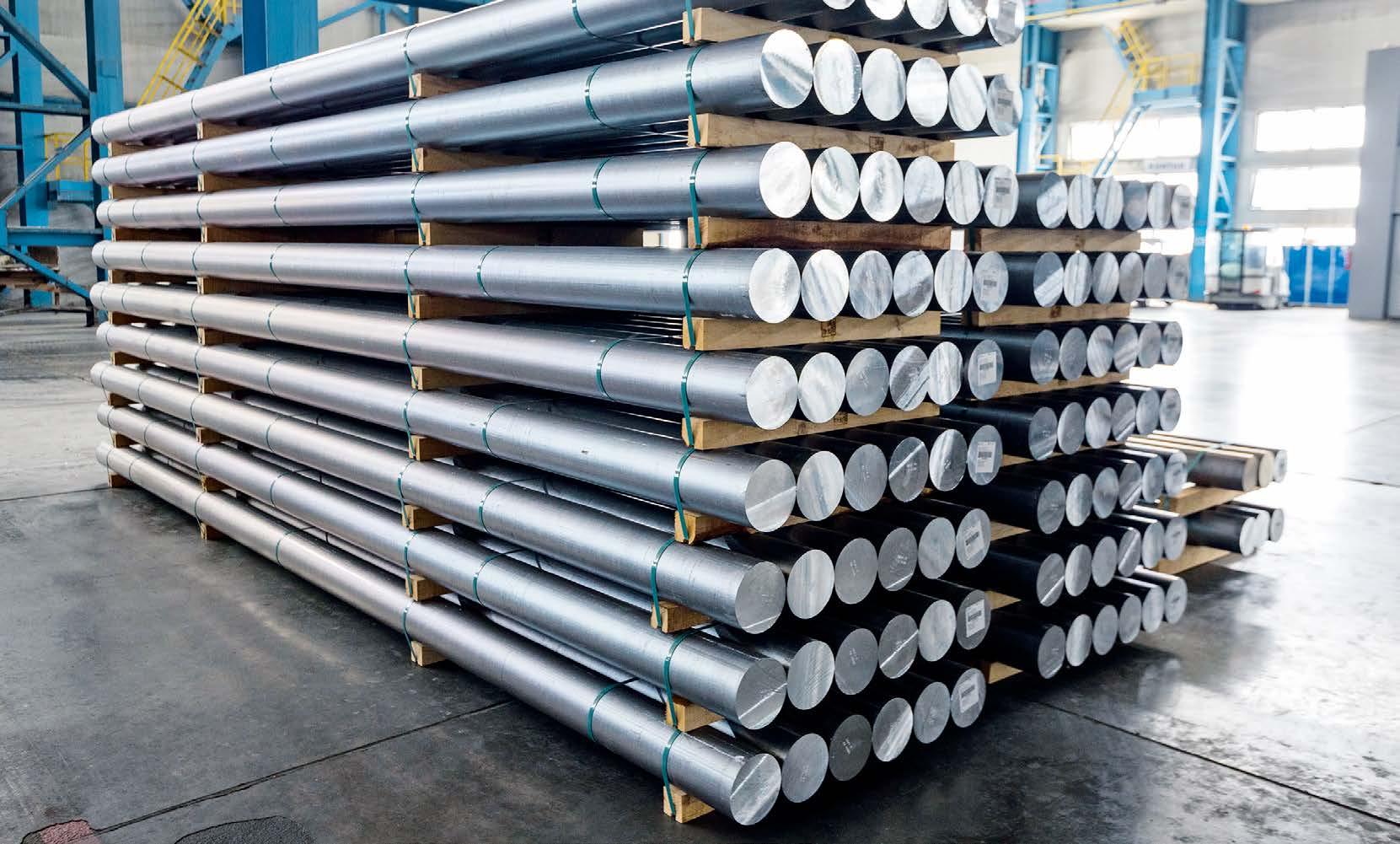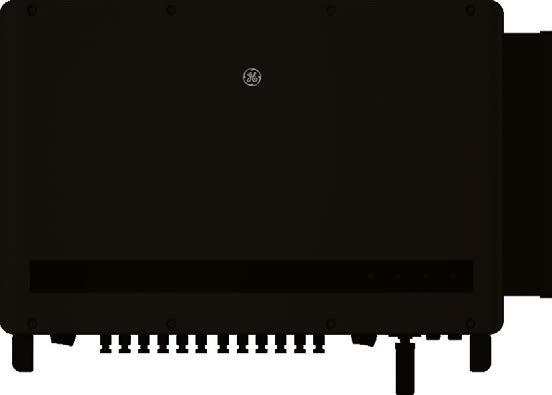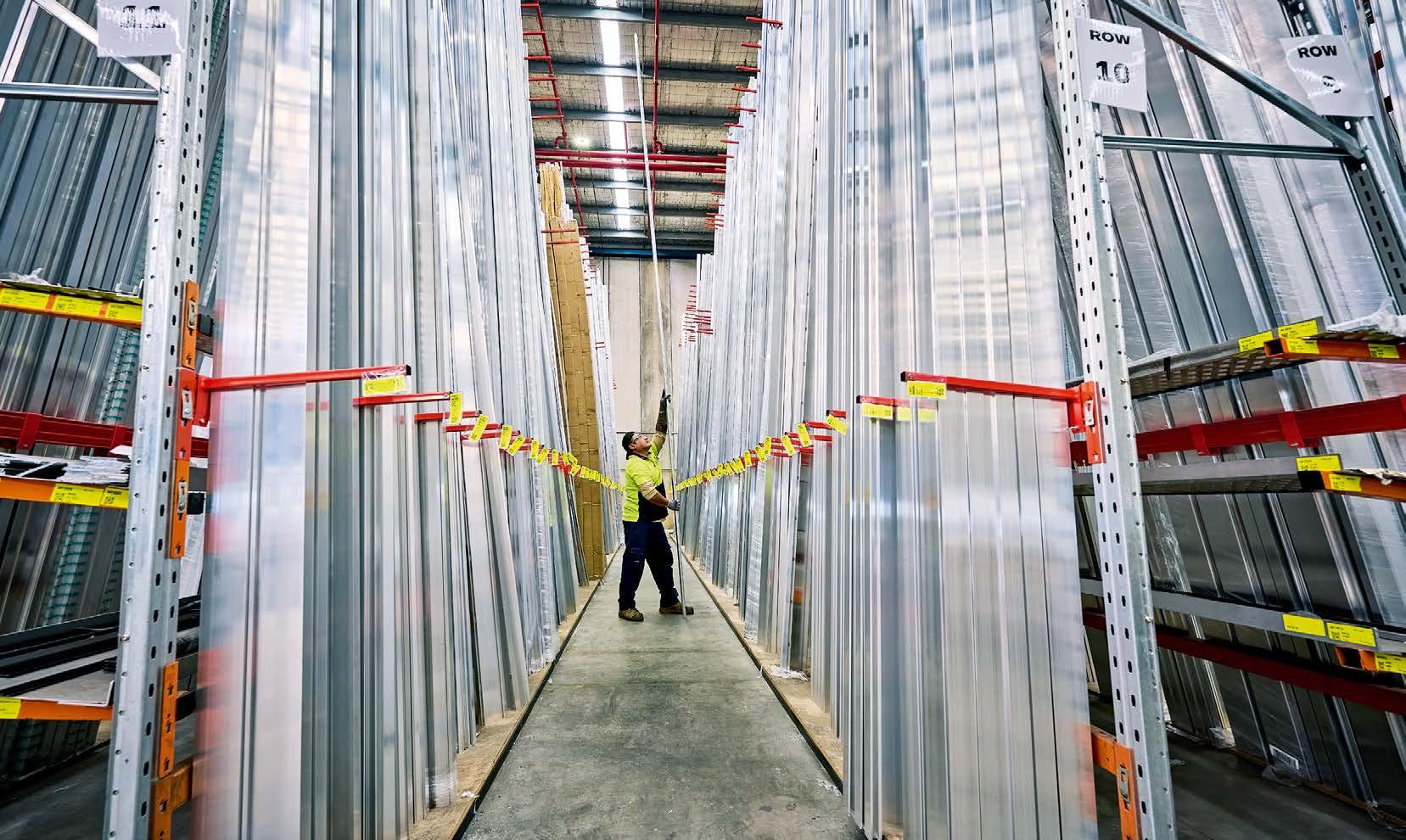
9 minute read
Capral pioneers low-carbon aluminium
LOW CARBON ALUMINIUM IN THE MAKING
Aluminium is lightweight, noncorrosive, strong, and in high demand in electricity‑ related applications, including conductor alloys, motors, generators, transformers and capacitors. Embodied carbon levels are however, of increasing concern to consumers. Sustainability now sits at the core of Capral Aluminium’s undertakings.
Advertisement
Where would we be without aluminium?
In today’s society aluminium is ubiquitous. It’s used in all forms of transportation from bikes to ships to spacecraft; also in packaging; and building and construction including windows, doors and roofing; it’s found in a plethora of electricity-related technologies; and a large range of household items from cooking utensils to furniture. Aluminium too is used in machinery and equipment; portable computer cases as well, in fact we read that material from used beverage cans is fashioned into casing for MacBook Air laptops and Pixel 5 smartphones. FIRST SOME SALIENT FACTS: Australian aluminium
smelters consume a fair whack of the power produced by the predominantly coal-fired national energy grid, somewhere between 10 and 14 per cent.
Such electricity use constitutes up to one-third of the cost of producing aluminium.
The global average carbon footprint for a tonne of aluminium is somewhere in the range of 16t CO2/tAl. Given our reliance on coal-fired power generation in Australia, locally produced aluminium would typically boast a footprint in this range.
And although scrap aluminium is a valuable commodity, Australia exports 95 per cent or more of its scrap to South Korea, Indonesia, India and beyond for recycling. Just five per cent is recycled onshore. Those numbers are trending upwards; in 2020, Australia exported 119,075 tonnes of aluminium for recycling overseas, a significant increase of 25.13 per cent from the previous year.
Few people may realise it, but aluminium possesses properties that enable it to be recycled almost indefinitely, and as such, it is the gift that keeps on giving. Notably, 95 per cent less energy is required in aluminium recycling processes compared to its production from ore, thus avoiding harmful emissions.
What if some or all these matters could be addressed in one bundle?
Such is the undertaking of Capral Aluminium, Australia’s largest producer and distributor of aluminium products. Foremost is an industryfirst initiative in which Capral Aluminium has signed an agreement with Australia’s largest aluminium smelter, Tomago Aluminium, to supply around 550 tonnes of postproduction scrap annually for remelting.
Production scrap from Capral’s Penrith extrusion plant will be baled and sent to Tomago Aluminium in the nearby Hunter Region to be remelted and added to new aluminium billet.
The development is significant for many reasons, not least because Tomago Aluminium uses around 10 per cent of the New South Wales power supply to produce 590,000 tonnes of aluminium per year. In contrast, recycling aluminium alloys requires much less electricity, a tiny fraction needed to make primary aluminium.
In simple terms, because the strength of the chemical bond between aluminium and oxygen is extreme, significant energy is required to split that bond and form the metal. However, with recycled aluminium, the bond has already been broken, thus reducing the energy intensity of the process. In a joint media release on the development
Tomago Aluminium noted global supply chains were experiencing significant disruption and the carbon footprint was an increasing consideration, and that the new arrangement would reduce in part the need for international shipping through already congested ports.
“We are delighted to be able to close the loop for Capral and Tomago in a true ‘cradle to grave’ aluminium alloy supply and recycle arrangement. Best of all, the product that is made in NSW is now recycled in NSW,” read a company statement. The arrangement with Tomago is a
In an Australian first Capral Aluminium has teamed with Tomago to pioneer higher recycled aluminium content in logs and billets
small start, given that Capral generates another 14,450 tons of scrap annually that is destined for export markets.
Michael O’Keefe, Capral’s General Manager of Marketing & Technology told Smart Energy “Capral is committed to working with our supply partners to look for opportunities to improve the efficiency of our processes, better manage our postproduction scrap and make procurement decisions to reduce our environmental footprint.”
Earlier this year, Capral Launched its Sustainability Roadmap. This program will track and advance key strategies through four focus areas.
Michael explained, “We have identified four initial sustainability pathways within Capral, inclusive of operational considerations. Our teams can adopt or implement changes in their area of our business to make a real and tangible difference. These are Energy, Waste, Paper and Purchasing; however, the business intends to continue and expand the program in future years to encompass key areas aligned with the UN Sustainable Development Goals.”
Capral views the rollout of this grassroots program as an opportunity to make a positive impact on its customers, staff, the environment, and the broader society, placing the organisation well on the path to reach Net Zero emissions by 2050, a commitment Capral CEO Tony Dragecivich announced as part of the 2021 Capral Annual Report.
“We are the first Australian aluminium extruder and distributor to set a net zero target, and this is important because we know sustainability matters to Australian manufacturers,” he said. “Customers increasingly ask our sales teams for evidence of our sustainability commitments, which we feel is important and want to provide with complete transparency.”
Aluminium Stewardship Initiative (ASI)
For those unfamiliar with the Aluminium Stewardship Initiative, it is a global initiative whereby producers, users and stakeholders in the sector commit to maximise the contribution of aluminium to a sustainable society. They do this by demonstrating responsibility and providing independent, credible and verifiable information regarding practices and improvements in ethical, social and environmental performance. That’s quite a checklist.
Since its inception in 2012 ASI has become the recognised global authority in aluminium stewardship. ASI currently has 232 members in 47 countries and has issued 128 certifications against the ASI performance standard. Capral is the first Australian aluminium extruder to become a member of ASI.
Capral aims to achieve certification for its operations under the ASI Performance Standard and ASI Chain of Custody Standard by mid2024 (or sooner if Michael and his team have their way!) as part of an all-encompassing approach to decarbonisation.
Evolution and Growth.
Be the first to see the new additions to our product range at All Energy 2022.


Backed by advanced knowledge and experience in research and development, we integrate the most advanced safety features and intuitive data monitoring to create a range of premium PV inverters and energy storage solutions.

“As a member of the ASI we are looking to become certified and credited to those standards, and among a raft of initiatives we have to change our procurement behaviour around aluminium, that is, our primary log or billet, which we will now aim where possible to purchase from ASI certified smelters,” O’Keefe explained.
“There is a threshold on carbon emissions for smelters producing ASI-certified billet, and we all need to move in that direction.
“These days architects, designers, engineers, manufacturers and tradespeople want to know where their aluminium has come from and that it has been produced in a responsible manner. Sustainability matters, and sustainable material procurement matters today,” O’Keefe emphasised.
“Society is moving to low carbon products, and many wheels are in motion to modify our emissions and manage the responsible procurement of aluminium.”
Under ASI’s certification process, members must commit to certifying at least one of their operations within two years of joining, but Capral is upping the ante by committing to certifying all six of its manufacturing facilities.
It dovetails neatly with Capral’s Sustainability Roadmap and public commitment to reach Net Zero emissions by 2050. Both place the organisation well on the path to ASI certification. Net zero by 2050
Efforts toward net zero will initially centre on Scope 1 emissions generated from company-owned and controlled resources and operations, and Scope 2 emissions from the generation of purchased energy and released in the atmosphere, O’Keefe said.
“Our focus is very much on eliminating the source of emissions. We intend to do this by improving our plant and equipment, implementing new technologies and embracing more sustainable practices across our organisation.
“Working with our upstream supply partners, we will continue to look for options to incorporate more low carbon aluminium in our value chain.”
He highlighted that progress toward net-zero will, in part, be underpinned by options presented by emerging and breakthrough technologies. “We have developed an extensive roadmap that goes beyond increasing renewable energy installations at sites and behavioral changes across all our operations, but much depends on emerging technologies and increased investment in renewables to give us the energy generation we require.”
Low carbon aluminium for the Australian Market
Much of Capral’s activity in the past 12 months has focused on putting in place a workable roadmap to achieve its ambitious sustainability targets. However, one significant change the business has made during 2022 is to actively procure primary aluminium billet for extrusion with a lower carbon footprint.
The global average carbon footprint for a tonne of aluminium is somewhere in the range of 16t CO2/tAl. Given our reliance on coalfired power generation in Australia, locally produced aluminium would typically boast a footprint in this range.
Yet, aluminium with a lower carbon footprint is increasingly available, and Capral has committed to being ready to meet local market demands for low-carbon aluminium in Australia.
“In 2022, 22 per cent of the primary aluminium billet Capral procures for use in its eight local extrusion presses will have a carbon footprint of less than 8t CO2/tAl with approximately 300t having a certified carbon content of less than 4t CO2/t Al,” Michael explained.
“Industry sectors like construction, renewable energy, transport and marine are looking for low carbon options for their products to meet customer expectations. Capral is ready to support these sectors with access to aluminium, almost 50 per cent lower in emissions intensity than they can currently source locally.”
All of this is excellent news for Australian businesses using extruded aluminium in their products, who can now consciously choose to use low carbon aluminium, literally cutting the carbon footprint of the aluminium in their products in half. A cleaner, greener choice all around.
Cleaner, Greener. More sustainable aluminium for your projects.
Capral now offers low-carbon aluminium with a certified CO2 content of 8tCO2/tAL or below. Make a responsible choice; choose locally extruded, low carbon aluminium from Capral.
For more information visit: capral.com.au











